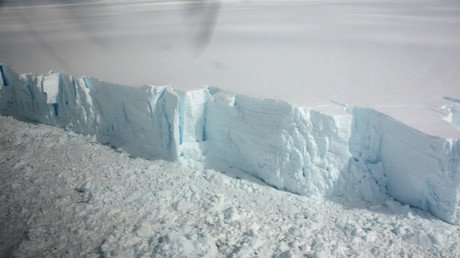Deep under ice it dwells: Scientists find ‘fully unexpected’ signs of life in subglacial Antarctic

Scientists experimenting on an Antarctic lake hidden deep under glacial cover made a surprising discovery when mud scrapped from an instrument lowered into its dark, icy depths revealed ancient signs of life.
The startling discovery was made in December, after a team from the Subglacial Antarctic Lakes Scientific Access (SALSA) expedition drilled a hole through a kilometer-thick slab of ice on Lake Mercer, located under an ice sheet some 600km from the South Pole.
The muddy haul first revealed the remains of photosynthetic algae that lived in the area millions of years ago, when the area now called the Antarctic was much warmer.
Also on rt.com VIDEO depicts disturbing extent of Antarctic ice melt since 1976The researchers were then thrilled to uncover a collection of higher lifeforms: crustaceans, the tendril of a plant or fungus, and an eight-legged tardigrade. Known as “water bear,” this micro-animal is an ultimate survivor, with experiments in the past seeing it withstand desiccation (total drying up of the body), solar radiation, both boiling and freezing temperatures, and even living over a week in outer space.
A previous drilling expedition at Lake Whillans in 2013, some 50km from Lake Mercer, found an environment brimming with microbes, but no signs of more complex life. Thinking that the specimens may have been initially introduced on contaminated equipment, the team cleaned the instruments and repeated the process only to find more ancient lifeforms in the mud.
Calling the discovery “fully unexpected,” David Harwood, a micropaleontologist with the SALSA team, told Nature magazine that the discovered remains were in excellent condition.
“It looked really fresh,” he said of one crustacean found with tiny, delicate hairs still attached. “Like something that had been living.” Another shrimp-like crustacean was found with legs still hanging from it and discolored “like an old leaf that’s been sitting on the ground for a season,” Harwood added.
Theories are now sprouting as to how the organisms came to be in the lake. Some suggest they may have lived in nearby ponds and streams during warm periods of glacial retreat between 10,000 and 120,000 years ago, before being washed into the lake through underground rivers deep beneath the ice or a moving glacier.
After covering up the bored hole in January, the SALSA team are now using carbon dating and attempts to sequence the creatures’ DNA in a bid to date them accurately and compare them to modern specimens. This may provide answers to how far the continent’s glaciers retreated millennia ago.
However, the surprise discovery may also inspire hope for those waiting on future exploration of extraterrestrial subglacial worlds. NASA is planning to drill into the frozen crust of Jupiter’s moon Europa in search for alien life, while closer to home on Mars stunning photos of a crater filled with water ice have teased space lovers worldwide.
Think your friends would be interested? Share this story!
















